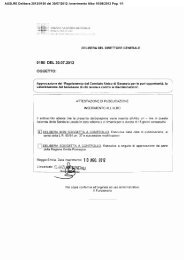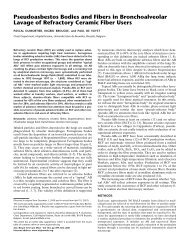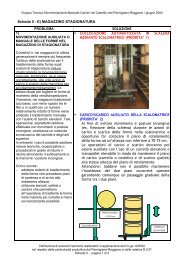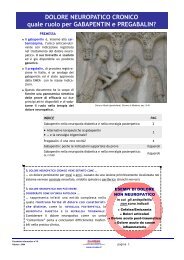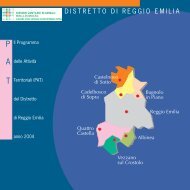Download PDF
Download PDF
Download PDF
- No tags were found...
You also want an ePaper? Increase the reach of your titles
YUMPU automatically turns print PDFs into web optimized ePapers that Google loves.
Home-based interventions for postpartum depression 11progress through the phases of a randomized trial, andelements of the CONSORT checklist such as recruitmentand follow-up procedures, method and implementation ofrandomization, baseline participant demographic and clinicalcharacteristics, sample size determination, and statisticalmethods used for analyses (Moher et al. 2001).Quality of future published studies can also be improved byproviding sufficient detail about the intervention that wouldallow it to be replicated with fidelity and reportingstatistical information needed to calculate effect sizes.Finally, to bring home-based PPD intervention research tothe attention of policy makers and increase the likelihood ofits wider adoption, future studies would benefit fromreporting cost data and cost-effectiveness analyses.While this review represents the first synthesis of thearray of home-based interventions aimed at preventing andtreating PPD, there are several limitations that must benoted. First, we were not able to conduct a meta-analysis ofthe studies in our review, as only three of the six studiesprovided sufficient information to permit effect sizecalculation (Chabrol et al. 2002; Cooper et al. 2003;Prendergast and Austin 2001). Second, it is unclear whetherinterventions that showed more immediate benefits intreating PPD continue to benefit women subsequently.Previous research has documented that among adults whorecover from depression, 25% experience a recurrence ofdisorder within the first year and 60% within 5 years(Solomon et al. 2000). Only three (Cooper et al. 2003;Prendergast and Austin 2001; Wiggins et al. 2005) ofthesix studies followed participants post-intervention and inthe one study that showed an effect of the interventionand followed participants over time, the effects were notmaintained (Cooper et al. 2003). Third, differences acrossthe studies in intervention duration and content, interventionproviders, depression measures, assessment timeframes, and study samples create challenges for comparingfindings across studies. For instance, interventionsranged in duration from six weekly sessions (Prendergastand Austin 2001) to 1 year of monthly sessions (Wigginset al. 2005) and only three studies used trained therapistsor intervention specialists (Appleby et al. 1997; Chabrol etal. 2002; Cooper et al. 2003). Furthermore, study sitesincluded settings in England, France, Scotland, Australia,and Sweden, therefore encompassing women of variedcultural norms and diverse environmental stressors. As aresult, the generalizability of these study findings to othersettings may be limited. Fourth, there were methodologicallimitations among the studies reviewed, including highattrition levels (Appleby et al. 1997), inclusion of womentaking antidepressants without accounting for the effectsof those medications (Holden et al. 1989; Prendergast andAustin 2001), and failure to report intent-to-treat analyses(Wickberg and Hwang 1996). In addition, only half of thestudies used a manualized intervention (Chabrol et al.2002; Holden et al. 1989; Prendergast and Austin 2001),conducted independent assessments (Appleby et al. 1997;Cooper et al. 2003; Holden et al. 1989), and took steps toensure adherence to the intervention protocol (Chabrolet al. 2002; Cooperetal.2003; Prendergast and Austin2001). These methodological limitations require that theresults of these studies be interpreted with caution. Finally,our review only included studies that used a RCT design.Promising findings have emerged from other home-basedinterventions to treat PPD, including the work of Ammermanet al. (2005) who used an adapted form of CBT to treat PPDamong women enrolled in paraprofessional and nurse homevisitation programs.In spite of these limitations, we believe this reviewaddresses an important gap in our knowledge about theopportunities to reduce the burden of postpartum depressionin women and their families. We see the growth ofhome-visiting programs—especially those targeted atpopulations with increased risk for depression anddisproportionate rates of untreated depression—as a wayto decrease disparities in access to evidence-based mentalheath prevention and treatment services. Partnerships withmental health professionals may offer an important tool tohome-visiting programs seeking to demonstrate their ownvalue and effectiveness. The evidence-based interventionsdelivered in the homes of pregnant and recently postpartumwomen reviewed here show promise. We hope ourrecommendations for future work in this area willencourage more high-quality studies to elucidate thefactors associated with positive outcomes for women atrisk for postpartum depression.Acknowledgements Support for this research was provided by theFamily League of Baltimore City, Inc., and the Maryland Governor’sOffice for Children.ReferencesAdministration for Children & Families (2006) Research to Practice:Depression in the lives of early head start families. U.S.Department of Health and Human Services, Washington, DCAmerican Psychiatric Association (1994) Diagnostic and statisticalmanual of mental disorders, 4th edn. American PsychiatricAssociation, WashingtonAmmerman RT, Putnam FW, Stevens J, Holleb LJ, Novak AL, VanGinkel JB (2005) In-home cognitive-behavior therapy fordepression: an adapted treatment for first-time mothers in homevisitation. Best Pract Ment Health 1:1–14Appleby L, Warner R, Whitton A, Faragher F (1997) A controlledstudy of fluoxetine and cognitive-behavioural counseling in thetreatment of postnatal depression. Br Med J 314:932–936Armstrong KL, Fraser JA, Dadds MR, Morris J (1999) A randomized,controlled trial of nurse home visiting to vulnerable families withnewborns. J Paediatr Child Health 35:247–244



